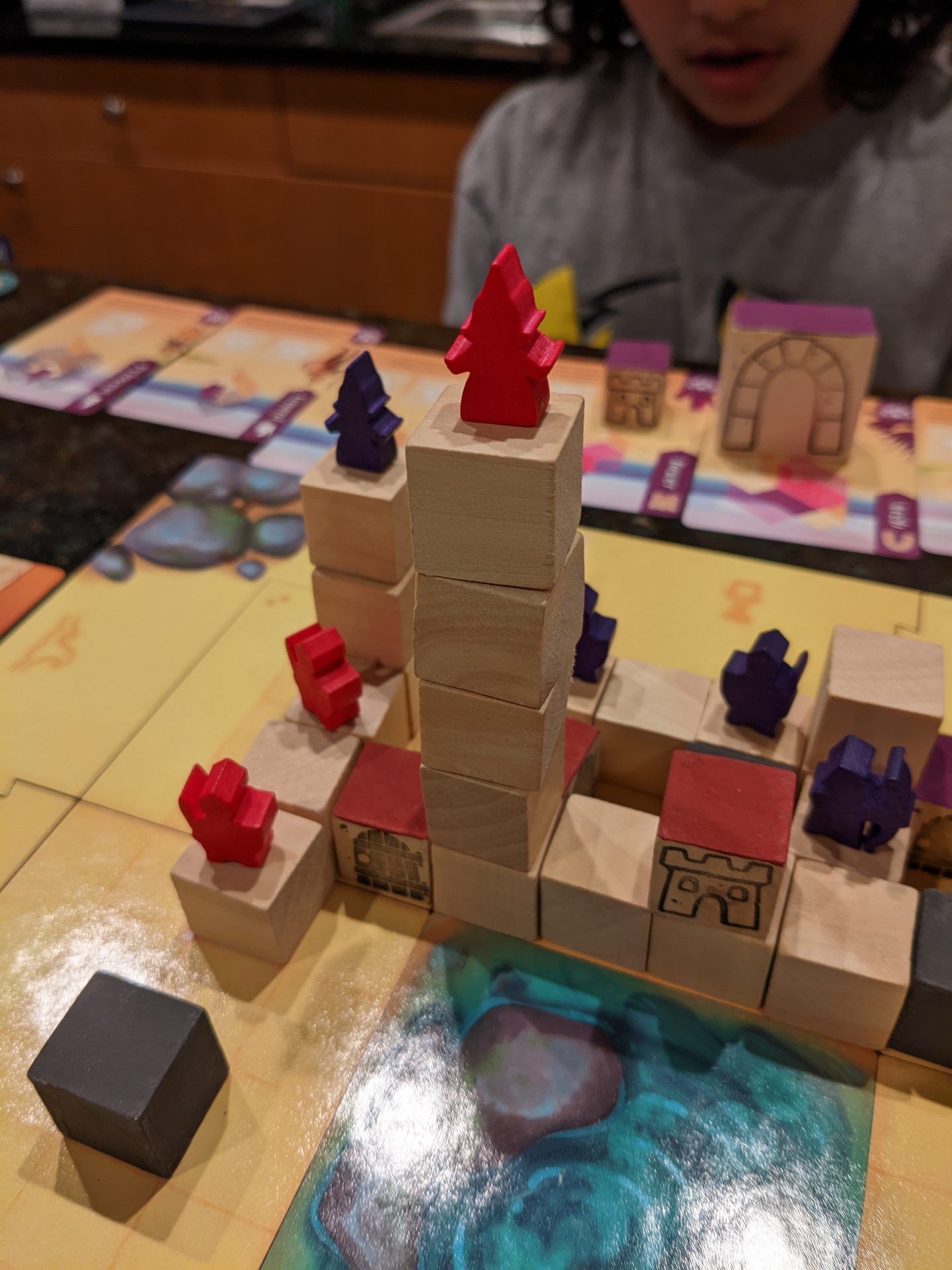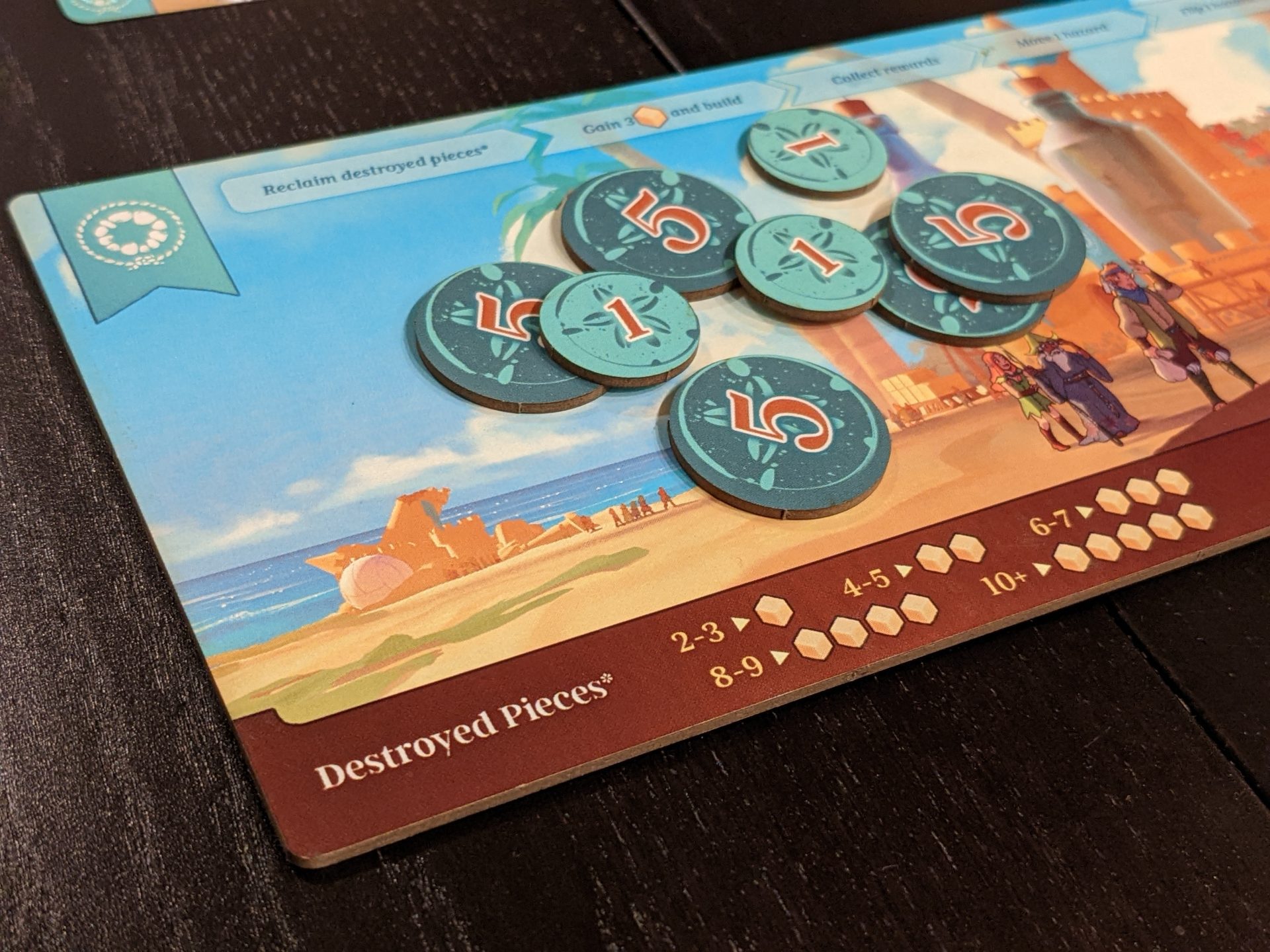I ran into Chris O’Neal at GAMA Expo recently. Chris is one of the founders at Brotherwise Games (Boss Monster, Overboss, Call to Adventure, Unearth), and he walked me through their next Brotherwise release, Castles by the Sea.
Designed by Jon Benjamin and Michael Xuereb, Castles by the Sea offers a light gaming experience for 2-4 players which rewards the spatial puzzle expert as well as fans of other Brotherwise games. Brotherwise was kind enough to send a prototype of the game for review just in time for the Kickstarter, going on right now!

Turns Are Breezy
Castles by the Sea is a building game, accessible to kids as young as 8 (my daughter joined me for one of my plays) and for all types of gamers thanks to a simple set of rules. The backstory is brief: you lead a band of “Shorelings” who happen to live near the ocean. By building up your community and erecting castles for your princess, archers, and guards, your goal is to gain the most sand dollars to win!
In the world of the Shorelings, the beach is a dangerous place. Hazards like “The Terror” (a dog), “The Giant” (a baby) and “The Dragon” (a kite) are making life difficult. Players work against each other to build quickly because these hazards could destroy your hard work.
The main board is a 3×3 square of tiles: one ocean tile in the middle, with 8 beach tiles surrounding it. There are a few stones (permanent blocks) on the board that can be used in combination with individual building actions, plus seaweed tokens that offer 2 sand dollars to anyone who builds on those first.
Players spend 4-6 rounds placing sand blocks (wooden cubes) on the game board, finding ways to score by placing pieces (meeples and wooden structures) in legal positions. Rewards come in the form of sand dollars: each placed piece provides an income of 1-2 sand dollars, which are collected both immediately and near the end of each of your turns. More of your pieces on the board each turn equals more sand dollars all game long.
After scoring that round’s income, the active player will move one of the three hazard tokens around the outside of the board. Of the remaining two tokens, one must be triggered, which means a card from that hazard’s deck is drawn. That may or may not spell disaster for the row/column where that token resides.

Each hazard has its own deck consisting of 6 cards. When a hazard card is revealed, it may or may not have Alert icons (in the form of exclamation points) and when any single hazard has reached 3 or more Alert icons, that hazard takes effect.
That might mean that everything higher than 2 blocks gets washed away. Or it could mean that all of the figures in a row get wiped. Each hazard has its own ruleset so you’ll know what’s coming.
Even with these hazards, Castles by the Sea is a very casual game. When players lose pieces in a round, they are compensated with extra building blocks on a future turn.
After all of the game’s main rounds are completed, there’s a bonus round: all players get the chance to complete one final hazard movement to try and demolish other players’ work before a final scoring round is done at the end of the game. In my experience, this gives players one final chance to target the player in the lead with hazards before that final scoring action.
Games of Castles by the Sea are fast and individual turns are quick. In a 4-player game, you’ll play only 4 rounds; fewer players, and you’ll play more rounds. I played this game multiple times at 2 players and once at 4 players, and even the 4-player game took only 45 minutes including the teach. Two experienced players can absolutely finish Castles by the Sea in 15 minutes.

This and That
The spatial component of Castles by the Sea is critical; you will constantly need to see every nook and cranny on a full board to know where you can best take advantage of what little time you have to score points. A “Lazy Susan” (an adjustable, rotating turntable) might prove invaluable.
My 4-player game of Castles by the Sea was significantly more interesting than the 2-player games. (I didn’t play the game at 3.) At 4 players, the board state is always changing, and it’s much more likely that you’ll have pieces destroyed by the time your turn comes back around. 4 rounds feels like the right amount of time for this also; with 2 players, you’ll play 6 rounds, and nothing really interesting happens in rounds 5 and/or 6 that couldn’t happen earlier in the game.
I also found the game to really lack in challenge at the 2-player count. If you are using existing blocks placed by the other player, most of your blocks will end up in the same area of the board. Then, you are BOTH incentivized to avoid destruction in that area of the board, meaning almost zero drama.

Castles by the Sea features personal goal cards, known as Castle cards. In any given game, you’ll only be able to score 2 of the 3 cards you are dealt to begin play. Some of these cards show a blueprint, a set of blocks that need to be built in a certain format, to score. Other Castle cards have written text describing a situation that must be met instead.
The range of Castle cards allows for some milestones to be much, much easier to achieve than others. Some of the shapes you need to build only require stacking your 3 starting blocks in a round on top of a stone to score.
Other cards require truly ridiculous things: getting 6 of your pieces (figures and structures) onto 6 different tiles to score. That almost certainly requires using the inner edges of the board, where the lake tile resides, assuming you can get the real estate. But then, the reward for pulling this off is only 3 points.
The Castle cards aren’t swingy, but some are just objectively better than others. Also, some of the cards feel possible only with the longer version of the game with fewer players. I have not played a game of Castles by the Sea yet where the winning margin was more than 7 points. The design steers games into close margin contests, so Castle cards could end up swinging the game.

I’m Picky About My Beaches
Castles by the Sea lands somewhere in the middle for me.
A lot of joy came for me when stacking blocks. The tactile element of Castles by the Sea landed well. I also enjoyed occasionally diverting the plans of an opponent with a crafty move, even if it wasn’t a big score for me. Just taking up a space where someone else wants to go, getting in the way of their master plan? Exciting.
On the downside, the challenge is low. It might be more fair to say that the interaction isn’t where I was hoping it would land. Castles by the Sea opens up more as a family game, and less as a thinky strategy game with my core gaming groups. My daughter had fun figuring out how to place all of her figures and structures; in a space with parents and children, this is a fun exercise to watch as children work out the best solution.
For adult-only games, I don’t recommend this game at 2 players because it runs a round too long, overstaying its welcome in an experience that is already pretty quick. In other words, more rounds don’t add enough to make the juice worth the squeeze.
The Castle cards are luck of the draw. You will have games where an opponent gets a couple of easy scores while you are trying to figure out how to get a certain 5- or 6-block configuration to line up on a future turn. In a game that is seemingly designed to always produce close games, this may irk the person at your table invested only in winning. (Your friend that loves to house rule games? They have already taken Castle cards out of the setup.)
I’ll certainly play Castles by the Sea again if given the option. To the game’s credit, it is just as accessible as all of the Brotherwise products I have played. Castles by the Sea is quite easy to get to the table and would make for a fine addition to anyone’s beachfront property as a family game to play while waiting for the tide to roll in. I was just hoping it would have more staying power.












Add Comment